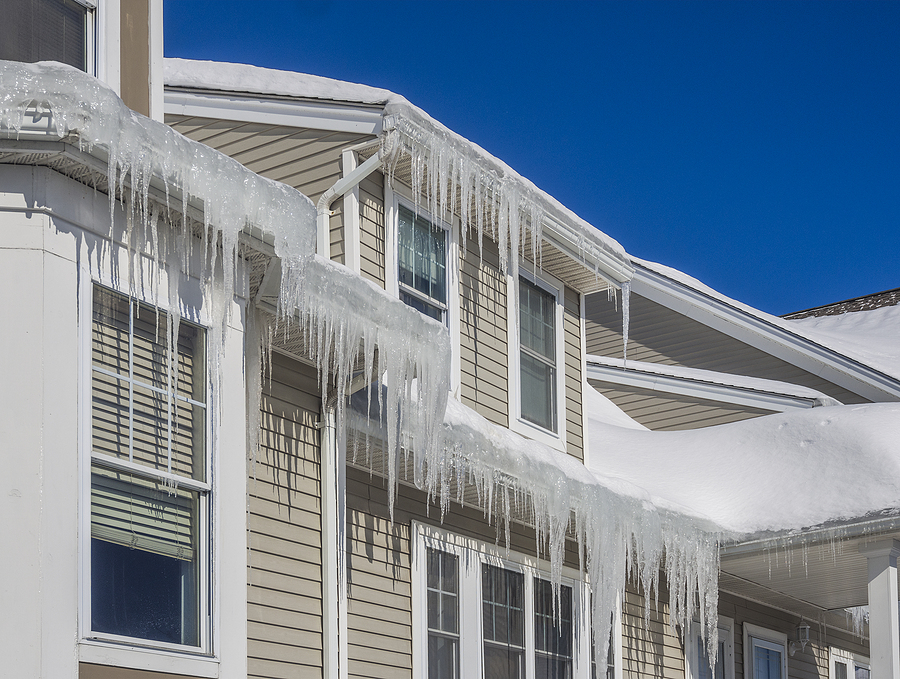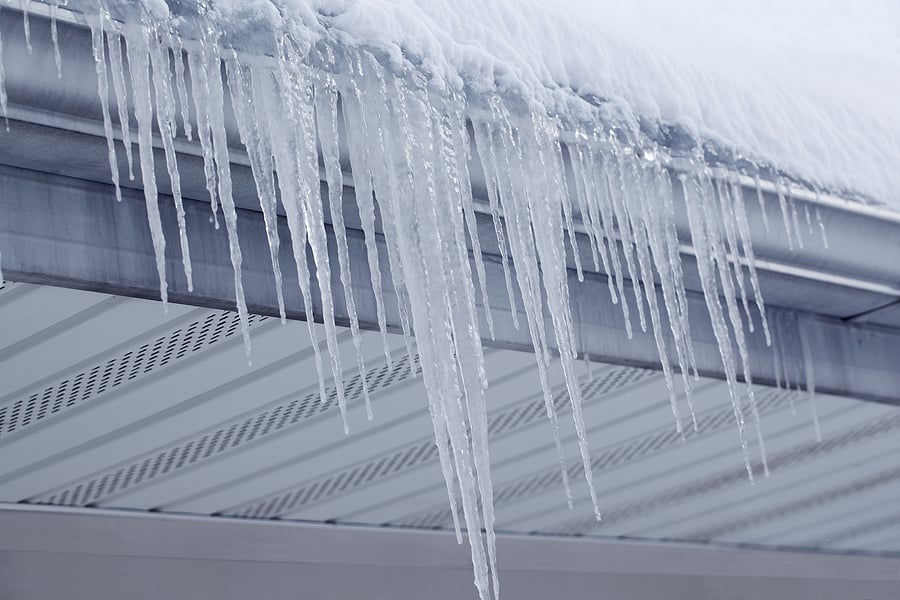ICE Dams: Causes and 3 Best Solutions for the Southern New England Homeowner

Whatever style of home, whatever the age, here in New England, ice damming can be a big problem in the harsh winters. Understanding what causes ice dams and how to prevent it will leave you with a winter-ready home with less potential for water damage as the ice thaws.
What is the Cause of an Ice Dam?
When snow accumulates on your roof, especially when that accumulation is over four to six inches, ice damming can occur. Then, when the outside air temperature increases to 34 degrees or more, and the sun beats down, the snow begins to melt. Then at night, temperatures drop below freezing rapidly, which causes ice to build up in the gutters and edge of the roof. Everything freezes up, creating a dam of ice that can wreak havoc on your home.
Here is what happens: without good insulation, your home heat is escaping out through your roof assembly. Ice dams form, and as the water sits, it begins to infiltrate the home.
How Can Ice Dams Damage My Home?
Snow and ice are a fact of life during New England winters. Why are ice dams such a big deal? If your home is not properly insulated, then the ice continues to melt. As ice and snow continue to accumulate over the winter months, the water builds up behind the ice dam, creating what amounts to a pond behind the dam. This cycle occurs again and again as one storm follows another, and the water comes into your home.
One major concern with water damage from ice dams is how your insurance company may handle it. If you experience this kind of damage to your home and file an insurance claim, the insurance company is likely only to address the symptom of the problem. So, you may get help repairing water damaged flooring, plaster or drywall, but the underlying condition—heat escape–will remain.
Your roof is designed to shed water, not hold water in one place. When water is left standing on your roof behind an ice dam, it will find the path of least resistance. Water will find its way behind the shingles, then will find a path below the shingles, through the roof, down through the ceilings and walls of your home.

What Can I Do to Minimize Ice Dams?
What can be done? The first step is to identify where heat is escaping. The best way to do this is to bring in a trusted contractor to have an infrared scan done. If the scan shows heat escaping through the roof, you know right away that ice dams can be a potential problem.
With an understanding of where the heat is escaping, you can formulate a plan with your renovation partner. When managing ice dam potential, you have several courses of action. Here are three main areas of focus.
1. Ventilation
As in any part of the home, there needs to be a balance between sealing the space against heat loss and creating good ventilation. An attic needs to be ventilated in part to prevent ice damming. The solution for this used to be what are called proper vents. Proper vents are problematic because they allow an effect called “wind washing” to occur. Wind washing is when air flows into the attic and hits the insulation, causing more heat loss. Having a qualified insulation specialist install a wind wash barrier vent will be the best solution to give your attic the ventilation it needs without compromising the R-Value of the insulation in your attic.
2. Insulation
Spray foam insulation is the gold standard. Spray foam seals up those spaces that other insulation can’t get to. It also dramatically reduces the stack effect, also called the chimney effect. When a home is poorly insulated, air finds its way in, and warm air is drawn up and out just like a chimney. The greater the temperature difference between inside and outside the greater the potential for the stack effect to occur.
Spray foaming the roof assembly (all the rafters and the gable ends) will drastically reduce the loss of heat of the home to the point the attic will become conditioned space. When your attic becomes conditioned, moderate temperature, not so cold in the winter and not so hot in the summer, you will see benefits beyond lowering the probability of ice dams. For instance, if you have an HVAC in the attic, spray foam will create a more consistent temperature, and the HVAC system will not have to work so hard, lowering your energy bills in the process.
Since spray foam is a more costly option, an alternative would be to remove old blown insulation, seal major gaps with spray foam, and install a new layer of blown-in cellulose insulation. This will help you meet current energy codes, achieving an R-38 value of insulation as a minimum.
3. Roofing
Water and Ice Shield
Another way to prevent ice dams is to make sure your roof has properly installed water and ice shields. A roof should have ice and water shields in the valleys of the roof, on the sides of dormers, and the sides of walls above other roofs, also called cheek walls. A well-qualified contractor will know best practices to install water and ice shields to keep water from infiltrating your roof assembly.
Heated Roof
For the very best defense against ice dams, insulation is just the first step. Ice can occur especially on the north, northwest side of the roof because those are areas where the sun will have less impact. Snow will melt but not go away. To stop the snow from building up on your roof, have a roof heating system (roof mat) installed. A roof heating system goes under the shingles and melts the snow on the leading edge of the roof. Just like rain, the melted snow goes down the gutters and is not left in a pond behind an ice dam on your roof. With this approach you can effectively eliminate ice dams. Mitchell Construction is a factory authorized installer of Heated Roof Systems Inc. an industry leader in heated roofing systems.
Protecting Your Home Against Ice Dams
Winters in this part of New England can be brutal. While nobody can guarantee elimination of ice dams, a good contractor who knows the science behind ice dams can help you minimize and prevent their impact on your home.
To learn more about home maintenance, please download our FREE eBook - Home Maintenance: This is How Professionals Do It. And if you are ready to speak about your next renovation, please schedule a home renovation discovery session.


Leave a comment